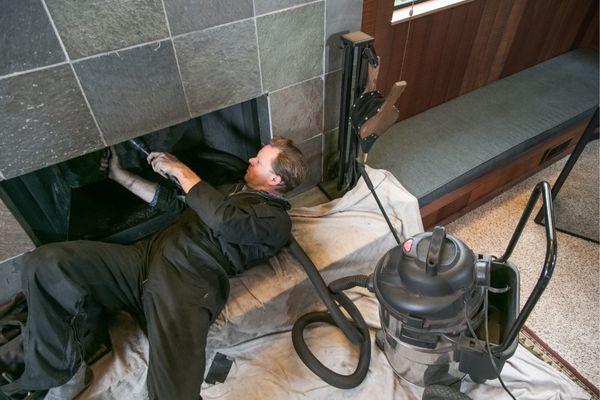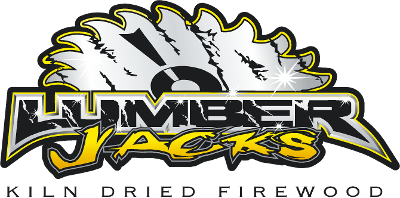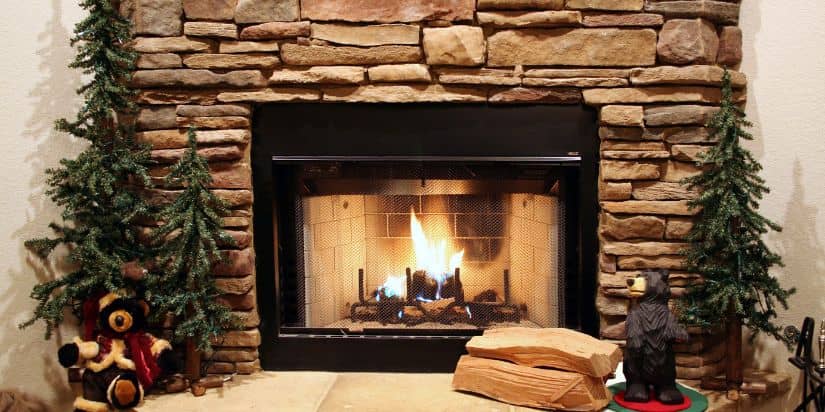We all dream of the perfect holiday scene: The kids are playing with their new toys, and you and your spouse are snuggling on the couch. What’s that in the background? The warm glow of a crackling fire. It ties the whole picture together, doesn’t it?
But that perfect fire in your fireplace doesn’t just happen. It requires intentional preparation to achieve cozy winter bliss.
Winterizing your fireplace now will prevent your fires from fizzling out too quickly or, worse, putting your home and family in danger.
Fortunately, winterizing a fireplace is not difficult. It only requires a few simple steps on your part. Here’s how to prepare a fireplace for winter the easy way.
If you need high-quality firewood for your harsh Midwest winter, Lumberjacks has you covered! Click the button below to learn more about our kiln-dried firewood.
1. Schedule an Annual Chimney Inspection
Before you use your fireplace this winter, you need to be sure it’s safe. The best way to do this is with an annual chimney inspection by a certified chimney sweep.
You may wonder why an annual inspection is necessary. After all, you probably used your chimney last winter, and it worked fine. The reason it’s necessary is a lot can happen to a chimney over a year.
For example, the rain slowly erodes the chimney material, creating cracks and leaks. These types of damage can lead to many problems, including:
- Decreasing the structural integrity of your chimney
- Causing housefires by letting heat escape to nearby construction materials.
- Leaving your home vulnerable to carbon monoxide leaks
- Making your fires less energy efficient
For this reason, the National Fire Protection Association (NFPA) recommends that all chimneys be checked at least once a year. Furthermore, if you’ve just moved into a home or have never used your chimney, your system should receive an extra thorough inspection.
The people best qualified to perform these inspections are chimney sweeps certified by the Chimney Safety Institute of America (CSIA). These pros can catch problems in their earliest stages when they might not be visible to untrained eyes.
For this reason, it’s better to pay a CSIA-certified chimney sweep to perform your inspection than to do it yourself. While you may save more upfront by inspecting your chimney on your own, you could wind up paying more for costly problems down the line.
2. Invest in Professional Repairs
Your chimney inspection may reveal structural problems that need attention. In this case, you’ll need to get those issues repaired before using your fireplace.
While fixing the damage to your chimney system yourself may be tempting, we recommend proceeding with caution. Only make the repairs if you’re sure you can do them safely. Making repairs incorrectly could put you at even greater risk of the problems listed above.
For example, let’s say you find cracks in your fireplace flue. The obvious course of action is to seal those cracks. But what’s not apparent is the type of mortar you should use. If you were to fill those cracks with regular mortar, the repairs wouldn’t last long because regular mortar can’t withstand the high temperatures generated by a fireplace. The cracks would only worsen over time, leading to more expensive problems.
For this reason, it’s a good idea to let a professional handle most fireplace and chimney repairs. A certified chimney sweep will know the best practices for winterizing your fireplace without any unexpected complications.

3. Make Sure Everything’s Working Properly
Aside from having your chimney inspected and repaired, you should also test some components of your system when winterizing a fireplace. These include the chimney cap, flue damper and fireplace gasket. We’ll discuss each of these in more detail below.
Check Your Chimney Cap
Every chimney should have a chimney cap. This component is essential because it keeps rain, snow, birds and other animals from infiltrating your fireplace system. Yet not all homes have chimney caps. So, we recommend having one installed if you don’t have one already.
If you have a chimney cap, it’s important to check it along with the rest of your chimney for signs of rust or deterioration. Metal chimney caps crack and wear away over time, leaving your fireplace vulnerable to unwanted visitors. Make sure you have protection overhead before you make the fire below!
Test Your Flue Damper
The flue damper is the mechanism you open to allow airflow up your chimney before starting a fire. It’s important to close the damper once your fire is out to prevent the warm air in your home from escaping through your chimney.
Therefore, you need to make sure you can open and close your damper without any problems before making a fire. An easy way to test this is to open the damper and put your hand beneath it. You should feel air flowing in from the chimney. If you don’t, the damper isn’t opening correctly and needs to be replaced.
You should also close the damper and put your hand beneath it to ensure you don’t feel any airflow. If you do, your damper isn’t keeping out the outside air like it should and needs fixing/replacing.
See If Your Gasket Is Sealing Properly
The gasket establishes a firm seal to keep a fireplace door tightly shut. However, the more often you open and close the door, the more likely the gasket will lose its adhesive properties.
So, check that your fireplace door firmly seals when you close it. If the door won’t stay shut, then it’s time to replace your gasket. Fortunately, this is an easy DIY project, and you can learn more about it here.
4. Thoroughly Clean Your Fireplace System
Many people wonder how often their fireplace chimney and flue should be cleaned. According to the NFPA, the answer is at least once a year.
This is because creosote, debris, dirt, soot and ash build up in the system with each successive fire you create. The longer these combustible materials go without being removed from the chimney, the greater the risk of a chimney fire. This buildup can also toxify the air in your home and threaten your family’s health.
Therefore, having your chimney cleaned by a professional sweep before using it in the winter is a good idea.
You should also keep an eye on your fireplace as you use it and clean it regularly. Remove and dispose of the ash after every few fires, and check the soot buildup to see when it’s time to wipe down the walls of your fireplace. You can do this by taking a metal poker and scratching the soot on the walls. If the amount of soot is greater than 1/8”, then it’s time to scrub it clean. We also recommend regularly cleaning your fireplace blower to keep it from filling your living room full of dust!

5. Clear the Area Around Your Fireplace and Chimney
Preparing the area around your fireplace and chimney for fires is also a good idea. Remove anything flammable from in front of your fireplace to avoid any fire hazards. Be careful not to let your stockings and Christmas tree hang too close to the fire!
You should also check your fireplace screen to make sure it’s in good shape, as this will prevent sparks from jumping into your living room.
Another best practice is to pay attention to the trees outside near your chimney. Trim away any branches hanging too close, which could be a fire hazard.
6. Follow Safe Fire Building Best Practices
Another part of winterizing a fireplace is following all fire safety best practices. These include checking the batteries in your smoke and carbon monoxide detectors and having a fire extinguisher nearby.
When it comes time to start your fire, remember to open the damper first so you won’t fill your home with smoke. Then, make sure you build your fire toward the back of the fireplace on top of the metal grate. We recommend igniting the kindling under a pyramid of firewood pieces and then periodically adding a piece at a time to keep the fire hot and steady.
7. Use Kiln-Dried Firewood for the Best Fires
The final way to prepare your fireplace for winter success is to feed it with the best wood available: kiln-dried firewood. This type of firewood is superior to traditional seasoned wood because it contains less moisture and is purified from all types of bugs, mold and fungus.
As a result, the firewood is super easy to light and produces the hottest flames. It is particularly good for fireplaces because it produces minimal smoke and creosote. As a result, it won’t dirty up your fireplace and chimney nearly as quickly as seasoned wood. Moreover, since it contains no insects or mold, it’s entirely safe to store inside for easy access when it’s time for a cozy winter fire.
You can learn more about this superior type of firewood by reading our complete guide on the topic.
Here’s to Staying Warm All Winter!
There you have it! Following these seven steps will set your family up for many great moments by the fireplace this winter. So, start winterizing your fireplace now because those snowflakes will be here before you know it!
Need help stocking up on kiln-dried firewood for the winter? We can help! At Lumberjacks, we produce premium kiln-dried firewood and deliver it everywhere in the Chicagoland region, including Arlington Heights, Schaumburg and Rockford.
Editor’s Note: This blog was originally published in November of 2022 and was updated in March of 2024.









